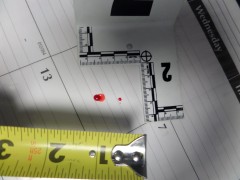This lesson is for : Grade 11,Grade 12:
Summary
This lesson will focus on the legal and forensic processes that occur during a crime scene investigation. The students will use a hands-on practical to resolve legal questions when processing a crime scene, the identification and collection of evidence, and the proper packaging of the evidence. Students will use information they learned in class and apply it to a mock scenario.
TIPC Ratings
Research & Information Fluency
Rating: Approaching – Explanation: Prior to beginning the crime scene practical the students received a step-by-step demonstration as they were learning about how to process a crime scene. This way they have an idea of how to set-up their own investigation. On the day of their investigation the students will construct appropriate questions to guide their investigation and to ensure that all legal obligations have been addressed prior to entering the scene. They will also need to assemble and organize information, like what type of personnel is required to assist with scene processing if needed and what is the best way to process the scene, in order to address the task at hand.
Communication & Collaboration
Rating: Approaching – Explanation: Students will need to work together as a team to assign specific roles to each student to ensure that all evidence is collected properly for future legal actions. They will use appropriate tools to process the crime scene and communicate their findings. After all paperwork has been turned in students will have a class discussion about how they feel the crime scene investigation went. The students will have an opportunity to go back through the crime scene with the teacher to ensure they did all parts of the investigation correctly.
Critical Thinking & Problem Solving
Rating: Ideal – Explanation: Based on the evidence obtained through questioning and the evidence at the crime scene students will need to determine if a crime was committed, what time of crime was committed, and who is the suspect. In order to accomplish this authentic task, they must think critically to to generate appropriate questions. They must problem solve to assess the crime scene in a manner that will enhance future legal actions. During debriefing, students reflect on their own roles as critical thinkers and problem solvers. They also get a chance to compare how they investigated with the demonstration given prior to the lesson.
Creativity & Innovation
Rating: Not observed – Explanation:





